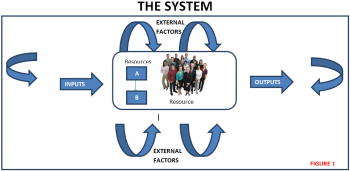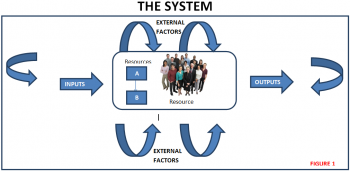Understanding the Whole and Not Just the Parts
I was very intrigued with this concept when I read it in the Business Analysis Body of Knowledge (BABOK). This concept is defined in the Underlying Competencies (chapter 8) of the BABOK. This concept is so powerful and if used more in organizations, it can produce remarkable events; however, I have found that Systems Thinking can only be utilized to its fullest potential if the culture of the organization allows for it. However, as business analysts this is a concept that we should have in our arsenal of tools as this concept can help to clearly identify the root cause of problems that need to be solved.
What is Systems Thinking?
According to the BABOK, Systems Thinking is defined as “Systems theory and Systems Thinking suggest that the system as a whole will have properties, behaviors and characteristics that emerge from the interaction of the components of the system, and which are not predictable from an understanding of the components alone. In the context of systems theory, the term ‘system’ is much broader than an IT system — it also includes the people involved, the interactions between them, the external forces affecting their behavior, and all other relevant elements and factors.” Most of the times, as business analysts we think of systems as an IT system as we are typically writing requirements either to build a new system or enhance/alter an existing system. A system consists of interaction, interrelated and interdependent parts, I remember these are the three “I’s” that form a complex unified whole. To break that down more granularly is that a system consists of inputs into the system, resources and processes within the system, and outputs produced from the system. These are you interacting, interrelated and interdepending parts (refer to Figure 1 below).
Please click the image to view it’s full size.
Systems Thinking is not just about focusing on the parts of a system but rather focusing on the complex unified whole. This way of thinking is taking business analysts to the next level because it’s not just about meeting deadlines to produce a result but rather how does that result you are producing fit into the organization as a whole?
Every system has a purpose, consists of parts that are arranged a certain way, can effectively react to change and for a system to be effective it must be stable. Systems Thinking is not just focusing on one part of the system but the entire system to ensure that it is a well-oiled machine. The danger of focusing on just one part of the system is that there is a potential of negatively impacting other parts of the system though the part being focused on is being improved. For example, in many of the industries I have worked in there are a lot of systems that have Band-Aids or some may call wraparound systems. Essentially what has happened is something has changed in the organization and in order to accommodate that change a temporary system is built. The system built solves the problem at hand as a temporary solution; however, this solution becomes permanent because it’s doing its job at hand. Therefore, no one goes back to the temporary solution to make the necessary changes to make it a permanent solution. After a while you end up with clusters of temporary systems to solve a permanent solution, which really doesn’t solve the problem at all. Then you sit back and wonder, “How did we get to this?” Well you got to it because no one thought about the consequences of not changing that temporary solution, the only thought was, we have a need now and we have to solve for it now. Systems Thinking is getting out of that way of thinking.
Systems Thinking allows organizations to:
- understand the strategic vision of the organization as a whole
- understand how the organization works and fits together as a whole
- understand the problems in the systems and understand the consequences of how solutions to those problems can affect the whole system.
Systems Thinking is a wonderful way to understand the root cause of the problem. For example, if there is a town that continually has fire outbreaks, just putting out the fires each time is not solving the root cause of why fires break out. The root cause could be that the town has no fire codes or the houses may not be equipped with smoke detectors. Putting out the fire is just a temporary solution but let’s say the town implements fire codes; this could potentially eliminate the fire breakouts. This is the beauty of Systems Thinking. It allows business analysts to determine the root cause of the problem and nip the problem at the root opposed to building out temporary solutions.
How can we apply this concept?
Let’s take the example of the fire outbreaks:
- First, identify the event/problem. The event in this situation is the fire outbreak in the towns.
- Second, identify the patterns. By asking a series of questions, patterns can be determined. For example, “What similarities in the house are causing the fires?” “What sections of the town are the fires breaking out?”
- Third, once the problems and patterns have been identified, then determine what solution can rid of the problem.
Sounds pretty simple but it’s amazing how often this is not done.
This is a powerful tool for business analysts to help implement better solutions. Start thinking about the projects you are working on and ask yourself:
- Why are we doing this project?
- How does this project fit into the organization’s strategic goals and long-term vision?
- How will the solution I recommend or help build meet those strategic goals or long-term vision?
- Am I solving for a temporary need and implementing a temporary solution; if so, what can I do as a business analyst to ensure that temporary solution doesn’t turn into a long-term solution? Or better yet, why are we doing a short-term solution for a long-term goal? What’s driving that need?
I do have to add that sometimes the answers to these questions are out of our control due to company culture but it never hurts to ask if your culture allows for that. In the long run you will be thanked.
Even if you have doing business analysis for years, it’s always good to step back and look at the projects you are working on and determine if the solution is really solving the root cause of the problem or just simply putting a Band-Aid to get past an immediate need. Even if you have to put on a Band-Aid for an immediate need it’s good to go back and ensure that Band-Aid has been removed and the long-term solution is implemented.
Let’s step our thinking up to the next level!
Don’t forget to leave your comments below!
Paula Bell is a Business Analyst, mentor and coach known for consistently producing exceptional work, providing guidance to aspiring business analysts (including those that just want to sharpen their skills), as well as providing creative and strategic ways to build relationships for successful projects. With 14 years in project roles to include business analyst, requirements manager, technical writer, project manager, developer, test lead and implementation lead, Paula has experience in a variety of industries including media, courts, carpet manufacturing, banking and mortgage. Paula has had the opportunity to speak on a variety of topics to include business analysis, project management, relationship building, diversity and software methodology.

